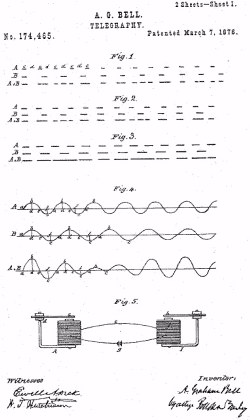For a detailed discussion of VoIP, try this link http://www.voip-info.org/wiki/view/What+is+VOIP

In essence, VoIP or Voice Over Internet Protocol, is an alternative way to send Voice (and now Video) between two or more people.The HistoryUnited States Patent No. 174,465 (right) was issued to Alexander Graham Bell on 7 March 1876 and became recognized as the most valuable patent in history. Yet early efforts to popularise the telephone were met with disappointment. Though people paid to hear Alexander Graham Bell lecture on “the miracle discovery of the age,” for a long time they seemed unaware of the telephone’s possibilities.What is perhaps less well known, is that two inventors not just one were responsible for “inventing” the first telephone.Elisha Gray independently invented an almost identical device, and he applied for a patent within hours of Bell.
Ultimately Bell’s invention was registered and a huge lawsuit followed with Bell victorious.From then until now, things have barely changed. Two people are connected together via a pair of copper wires that run across the street, across the town or across the world. The costs of maintaining all that copper is huge and this is reflected in the prices charged for the privilege – some could also unkindly single out our small Telephony marketplace and compare exhorbitant prices here to elsewhere in the OECD !The Advent of VoIPAvailable to big business for some time now, the available services, software and hardware has now come of age, and is readily available for home and small business users.Instead of converting sound into electrical pulses, voice (and video) is converted into media formats very similar to well-known “codecs”such as .wav and .mp3. These are then sent over the Internet to a destination that can convert the media stream back into sound (and video). This can be as simple as direct from PC to PC – along the lines of SKYPE, or as is now available, an “offnet” connection allowing VoIP callers to connect to olde-fashioned Post-Office Telephone Service (or the retronym Plain Old Telephone Service – POTS) if the callee doesn’t have VoIP enabled telephony.The ability of a VoIP service provider to allow our VoIP phones to call ordinary POTS telephones (and vice versa) is absolutely fundamental to our ability to use VoIP to its fullest extentOptions AvailableAll options assume you have Broadband connection of some form. For each simultaneous call you want to be able to make, it is recommended that you have at least 30Kbs of broadband capacity in each direction (ie up and down). To actually check how much bandwidth you really have, not just what you pay for, visit http://speedtest.net. Whilst calls can theoretically be made with lesser resources, we advise adherence to this guideline.So, if you have an office with 4 people who need to be able to use the phone at the same time, then allow 4 x 30 Kbs, or 120 Kbs. And that is spare capacity. If people are busy surfing the net, or downloading large files, please take account of that in your calculations – or ask us about implementing Quality of Service (QoS) on your Broadband connection.
Given that your broadband matches the recommended criteria, then what options are there?
ATA – The simplest and most common way is through the use of a device called an ATA (analog telephone adaptor). The ATA allows you to connect a standard phone to your Internet connection for use with VoIP. The ATA is an analog-to-digital converter. It takes the analog signal from your traditional phone and converts it into digital data for transmission over the Internet.
Voip Phone – These specialized phones look just like normal phones with a handset, cradle and buttons. But instead of having the standard RJ-11 phone connectors, IP phones have an RJ-45 Ethernet connector. IP phones connect directly to your router and have all the hardware and software necessary right onboard to handle the IP call. Wi-Fi phones allow subscribing callers to make VoIP calls from any Wi-Fi hot spot.
Soft Phone – This is certainly one of the easiest way to use VoIP. All you need is the software, a microphone, speakers, a sound card and an Internet connection, preferably a fast one like you would get through a cable or DSL modem.
Asterisk – As requirements become more complex, an internal PBX must be considered. It gives amazing flexibility yet remains surprisingly cost-effective. The industry standard Asterisk server is the norm for small to medium businesses who seek the utmost from their telephony investment. The down side is that maintaining an Asterisk server is an ongoing issue, and certainly changes to add new extensions or change incoming call handling requires specialised knowledge.
Bespoke PABX – The ultimate is the modern bespoke PBX. We supply PBX solutions with very simple interfaces allowing most office IT-savvy people to maintain their own calling systems. Adding extensions is easy, and the GUI software is unbelievably comprehensive. Systems with capacity for up to 25 phones are the starting point – but you don’t have to use all 25 at once !! Even as few as 6 people can make this a very attractive option purely because of the power and flexibility of the system.